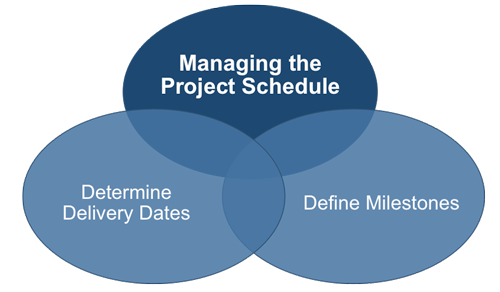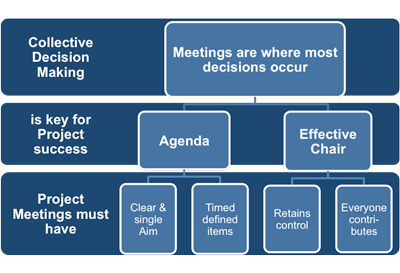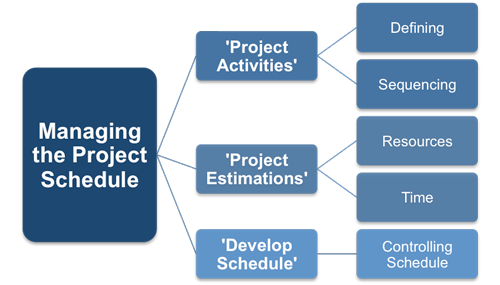Managing the Project Schedule
Managing the project schedule includes all of the steps required to ensure the timely completion of the project. It involves determining the delivery dates and milestones whilst taking all of the known constraints into account.
Generally speaking the level of detail needed is proportional to the level of risk and uncertainty associated with the activity. For this reason schedule planning should be carried out with the input of the project team that is going to actually do the work.
 |
This ensures that the sequencing and activity duration estimates are as realistic as possible as just as importantly, that the team feel as though have some ownership of them rather than seeing them as something that has been imposed on them.
Managing the schedule is sometimes seen as the core discipline of project management and some software tools focus almost exclusively on this aspect. It is a logical way of taking the project plan and creating a sequence and schedule for producing the project deliverables.
It is required through all phases of the project lifecycle and is normally derived at a high level during the initiation process in order to provide a framework in which the project plan can evolve as the project iterates between planning, execution and monitoring.
 |
Collective decision-making is very important area of project management that can make or break this part of the project. Almost all of the project processes that form part of project schedule management will involve meetings between the project manager, the team and other stakeholders in order to make decisions about the activity definitions and associated estimates. How well these meetings are conducted will have a major impact on how smoothly the project runs.
These meetings need to have a clear agenda and a chairman who can keep them running on schedule. If you do not take steps to make this happen then these meetings can easily become bogged down and fail to produce the required outputs when they are needed.
When estimating work it is inevitable that there will be disagreements about the time required and the resources needed. People will have different opinions of how much effort is involved to complete an activity based on similar work they have undertaken in the past. This type of disagreement is to be expected and only becomes a problem when discussions are allowed to drag on beyond the point when a 'reasonable' estimate could be made.
For example, early on in this process it really does not matter if an estimate for an activity duration is 5 days or 8 days. This is something that will become clear once the work starts.
A good chairman working to a properly timed agenda can ensure that 'good enough' decisions are made in a timely manner and that project team members are not left idle because the planning process is overrunning.
If you feel as though your project meetings could be improved then you can download the 'Meeting Skills' eBooks from this website. These free eBooks cover all aspects of meetings including how to set an agenda that will ensure that the meeting achieves it's aims and how to chair a meeting so that it is as productive as possible.
Managing the project schedule involves planning the work and working the plan as follows:
 |
Defining the Activities - the high-level requirements are broken down into high-level tasks or deliverables. These are then broken down into activities and presented in the form of WBS (Work Breakdown Structure).
Sequencing the Activities - the activities identified in the previous step should be sequenced based on the order in which they need to be done depending on their interdependencies.
Estimating the Resources Required - the estimation of the amount and the types of resources required for activities is done in this step. The project management team will need a clear understanding of resource availability and capability.
Estimating the Time Required - this is a key step in the project planning process and there are a number of tools that can also be utilized to help you to estimate the required activity resources. Most of the organizations follow either Work Breakdown Structure (WBS) based estimating or Function Points based estimates in this step. Once the activity estimates are completed, the critical path of the project should be identified in order to determine the total project duration. This is one of the key inputs for the project schedule management.
Developing the Schedule - in order to create an accurate schedule, several parameters from the previous steps are required including: the activity sequence, duration of each activity, and the resource requirements. Software packages, like as Microsoft Project, can help you to develop a project schedule including planning diagrams that can help to present the relevant information in a way that makes it easy to understand.
Controlling the Schedule is sometimes referred to as 'working the plan' in contrast with the earlier processes which are all to do with 'planning the work'. No project can be executed without changes to the original plans and schedules and this process will run throughout the project.
On some projects, especially those of smaller scope, defining activities, sequencing activities, estimating activity resources, estimating activity durations, and developing the schedule are so tightly linked that they are viewed as a single process that can be performed by a person over a relatively short period of time.
All of the activities detailed above must be preceded by a planning effort by the project management team. This planning effort produces a schedule plan that selects a scheduling methodology, a scheduling tool, and sets the format and establishes criteria for developing and controlling the project schedule.
A scheduling methodology defines the rules and approaches for the scheduling process. Some of the better-known methodologies include critical path method (CPM) and critical chain.
The finalized and approved schedule is the baseline that will be used to developing and control the schedule. As the project activities are being performed, the majority of effort will occur in this process to ensure completion of project work in a timely manner.
You may also be interested in:
Managing the Project Schedule | Defining the Project Activities | Sequencing the Project Activities | Estimating the Resources Required | Estimating the Time Required | Developing the Project Schedule | Controlling the Project Schedule.
|
|


